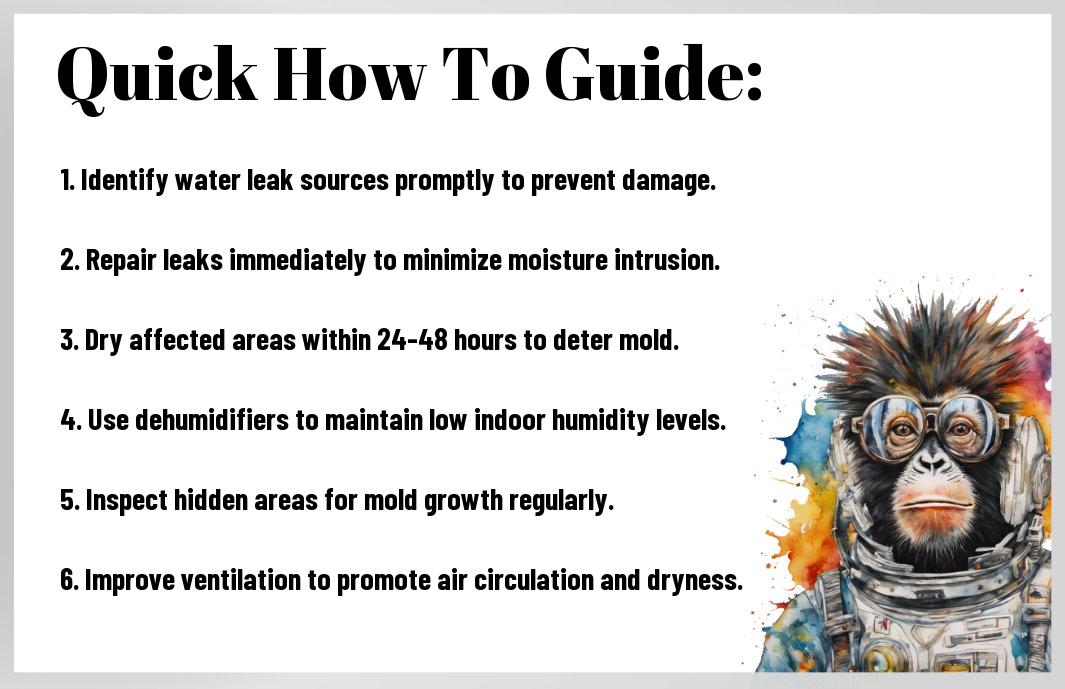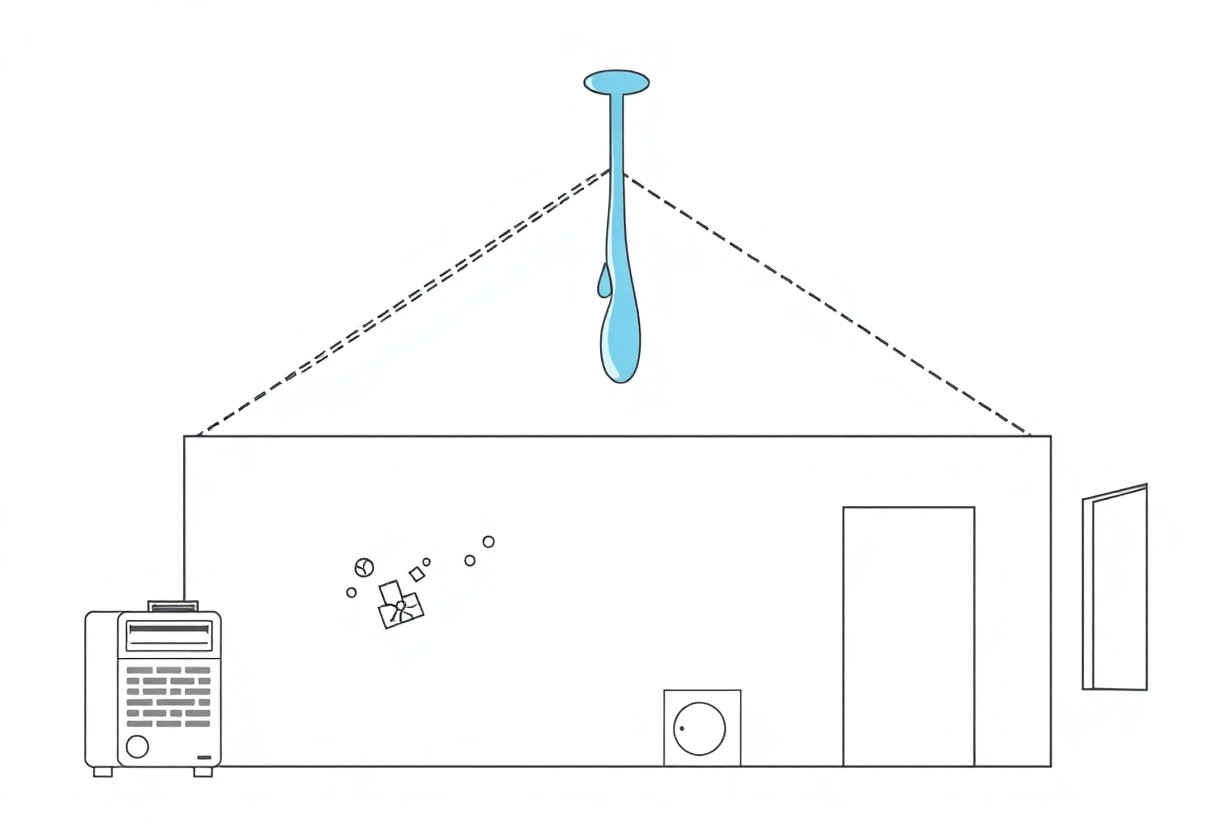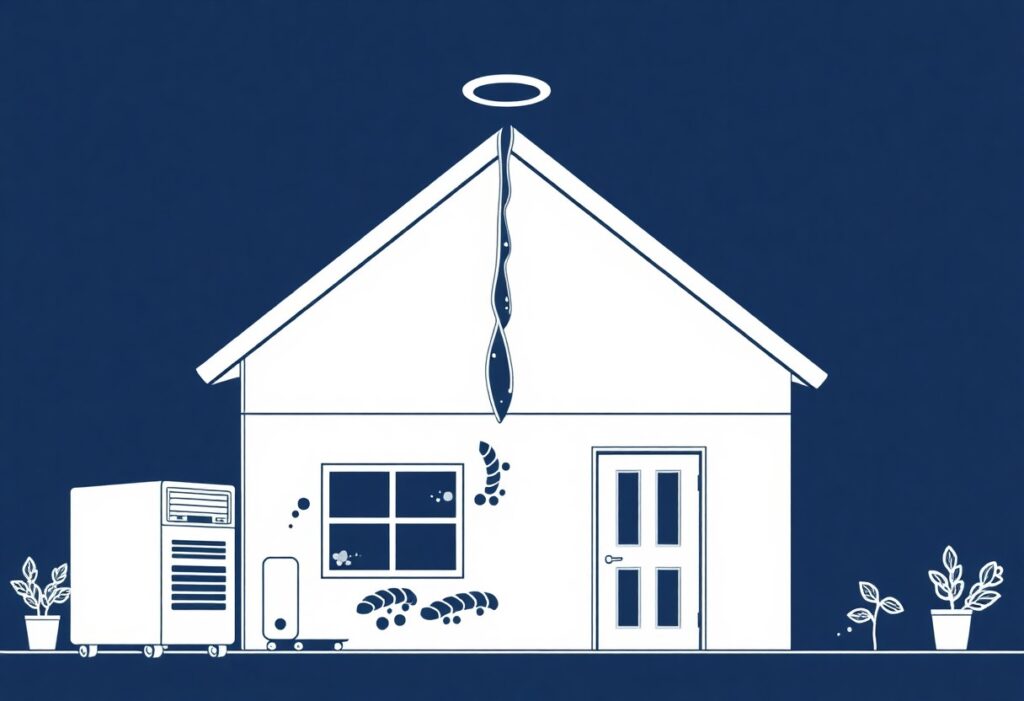Many homeowners underestimate the dangers of a single water leak, but it can lead to significant mold growth in just a matter of days. Understanding how water damage occurs and taking preventative measures is vital to keeping your home safe. In this guide, you will learn how to identify potential water leaks, recognize the signs of mold, and implement effective strategies to protect your home from further damage. Don’t let a small leak lead to big problems – your health and home depend on it!
Key Takeaways:
- A single water leak can indeed lead to mold growth if not addressed promptly; moisture creates an ideal environment for mold spores to thrive.
- Regularly inspect for leaks in areas prone to water exposure, such as under sinks and around appliances, to prevent mold issues before they start.
- Implementing proper ventilation and humidity control in your home can significantly reduce the risk of mold even if a leak occurs.
Understanding Water Leaks
A water leak is not just a minor inconvenience; it can lead to serious issues within your home. Understanding how these leaks occur can help you identify potential risks early. Common sources of water leaks include damaged pipes, faulty appliances, and weather-related damages. Ignoring even the smallest leaks can result in significant water damage, leading to costly repairs and inviting unwanted issues like mold growth.
How Water Leaks Occur
Leaks often start when there are weaknesses or failures in your plumbing system. For instance, age, corrosion, and physical stress can cause pipes to develop cracks or holes. Additionally, connections and joints may loosen over time, leading to slow drips that often go unnoticed. Appliances such as washing machines and dishwashers can also be culprits when they wear out or have malfunctioning hoses. You must be vigilant in monitoring your home for any signs of moisture so that you can address the issues before they escalate.
Factors That Contribute to Mold Growth
Occur in areas with excessive moisture, mold growth becomes a significant risk. Several factors contribute to this, including high humidity levels, poor ventilation, and the type of materials used in your home. When you have even a small water leak, it creates an environment that mold loves—a moist and warm area where it can thrive. Over time, the presence of mold can compromise the air quality in your home and pose health risks to you and your family. Being aware of these factors can help you take proactive steps to mitigate any potential mold issues.
- moisture
- humidity
- ventilation
- materials
That makes it vital to regularly check for leaks and maintain your home’s interior environment. Factors like water standing in one place for more than 24 to 48 hours can solidify the chances of mold growth. Simple actions such as monitoring humidity levels, ensuring proper ventilation, and quickly addressing any water issues can significantly minimize mold risks in your home. Recognizing the signs early is key to preventing long-term damage and maintaining a healthy home environment.
- early detection
- long-term damage
- healthy home

How to Identify a Water Leak
The process of identifying a water leak in your home requires vigilance and attention to detail. Since some leaks can be hidden behind walls or underground, it’s important to be proactive in your search. Start by regularly inspecting your plumbing fixtures, including faucets and toilets, for any signs of drips or puddles. It’s also wise to check the meter box after a period of water usage; a shifting meter may indicate an underlying issue. Utilize your senses — listen for dripping sounds or observe if there are damp spots where they shouldn’t be.
Tips for Spotting Hidden Leaks
Little leaks can sometimes lead to significant water damage over time, so detecting them as early as possible is key. Here are some tips to help you spot those hidden leaks:
- Check for discoloration on walls or ceilings, which may signal water intrusion.
- Monitor your water bill; unexpected increases can suggest a leak.
- Inspect the water meter; note the figures, and after a few hours of no water usage, check them again to see if they’ve changed.
- Look for mold or mildew, particularly in areas with poor ventilation.
- Examine exterior walls and foundation for signs of seepage or eroded materials.
Assume that even the smallest signs could lead to bigger issues down the line, and act promptly to investigate further.
Common Signs of Water Damage
Damage from water leaks can often go unnoticed until it has caused substantial issues in your home. Look out for signs such as stained walls, peeling paint, or bubbling wallpaper. You may also encounter unexplained mold growth in corners or behind furniture, and warped flooring may indicate underlying problems. Other signs include a persistent musty odor or visible pooling of water in certain areas. Such indicators should make you cautious about the potential for leaks.
Tips for actionable strategies include regularly checking areas prone to leaks, such as near appliances or fixtures. If you detect any of these signs of water damage, it’s advisable to consult a professional for a thorough inspection. Your home’s integrity relies on being vigilant against water leaks, as they can lead to extensive mold growth and structural issues. Protecting your home means addressing these concerns promptly, ensuring a safe and healthy living environment.
The Relationship Between Water Leaks and Mold
Now, it’s important to understand that a single water leak in your home can set the stage for mold growth. When water seeps through building materials such as walls, ceilings, or floors, it creates a damp environment that mold thrives in. Without proper mitigation, even a small leak can quickly escalate into a festering problem. Mold spores, which are naturally present in the environment, require moisture to germinate and proliferate, making a water leak a perfect catalyst for their growth.
How Quickly Mold Can Develop
Some types of mold can start to grow within just 24 to 48 hours after water exposure. This rapid development showcases the urgency with which you must address any water leaks in your home. If left untreated, these spores can multiply exponentially, leading to a potentially hazardous environment that could affect your health and the structural integrity of your property.
Key Factors Influencing Mold Growth
You should be aware that several key factors play a significant role in mold growth within your home. These include the availability of moisture, the presence of organic material for the mold to feed on, and a suitable temperature range. Moreover, poor ventilation can exacerbate these conditions, creating a perfect storm for mold proliferation. Conditions that allow these factors to align can lead to a severe mold issue in a very short amount of time. Recognizing these factors can empower you to take preemptive measures and protect your home.
- Moisture: Essential for mold growth.
- Organic Material: Provides nourishment for mold.
- Temperature: Most molds thrive in warm conditions.
- Poor Ventilation: Contributes to mold-friendly climates.
Influencing mold growth often comes down to how proactive you are about your home environment. Ensure that all leaks are repaired immediately and that moisture is kept to a minimum throughout your home. Regular checks on areas prone to dampness—like basements and attics—are vital to prevent mold from taking root. In addition, investing in proper insulation and ventilation systems can work wonders in creating a mold-resistant atmosphere. Recognizing these structural aspects can significantly reduce the likelihood of encountering a mold infestation in your living space.
- Proactive Measures: Regular inspections prevent serious issues.
- Insulation: Proper insulation reduces moisture build-up.
- Ventilation: Good airflow helps keep areas dry.
- Immediate Repairs: Addressing leaks prevents mold growth.

Preventative Measures Against Water Leaks
To maintain a safe and healthy environment in your home, you must take proactive steps to prevent water leaks before they become a significant issue. By implementing a few simple strategies and staying vigilant in your home maintenance routine, you can avoid unwanted water intrusion and reduce the risk of mold growth. For more insight into the risks posed by mold, you can check out the article about Is it unsafe to be in a building where there is mold … due to water leaks. Conducting regular checks and investing in quality materials will undoubtedly help you keep your home safe from these risks.
Tips for Regular Home Maintenance
Clearly, integrating regular maintenance checks into your household routine is a wise decision to prevent water leaks. You can minimize the risk of leaks by following these tips:
- Inspect pipes and appliances for signs of wear or corrosion.
- Clean gutters and downspouts to ensure proper drainage.
- Regularly check your roof for missing shingles or damage.
- Ensure that seals around windows and doors are intact.
- Monitor your water bill for unusual increases that may indicate leaks.
By taking these preventive measures, you can significantly reduce the chances of encountering serious water issues in your home. Thou will gain peace of mind knowing you are taking necessary precautions.
Importance of Immediate Repairs
Water leaks can cause considerable damage in a short period. When a leak occurs, the water must be addressed swiftly to prevent further complications, such as structural damage or the emergence of mold. Even a small leak can escalate quickly, resulting in costly repairs and potential threats to your health and safety.
With immediate attention to leaks, you not only protect your home from extensive damage but also guard against the formation of mold, which can contribute to serious health problems. Water that sits in hidden areas can create an environment perfect for mold growth, often leading to issues like respiratory complications. Therefore, fixing water leaks as soon as they are detected is necessary, ensuring your home remains a safe space for you and your family.
How to Address Existing Mold Issues
For homeowners dealing with mold, addressing the issue promptly is vital to protect your health and your property. Mold can cause a range of problems, from structural damage to respiratory issues, so taking the right steps is vital. Be proactive about assessing the affected areas, eliminating any moisture sources, and considering remediation options. Knowing how to effectively deal with existing mold will set you on the right course towards restoring your home to a safe state.
Professional Removal vs. DIY
If you’re contemplating mold removal, you may find yourself weighing the benefits of professional services against DIY efforts. Hiring a professional mold remediation service can significantly reduce the risk of improper handling, which could lead to further infestation or health risks. These experts are equipped with specialized tools and protective gear to manage large infestations safely, ensuring that mold is removed entirely and prevented from returning.
If you choose the DIY route, it’s important to be aware that minor cases might be manageable with appropriate precautions, but the tools and techniques for effective mold removal are not always readily available to the average homeowner. Moreover, without the right experience, you risk not addressing the root of the problem or even missing hidden mold that may exist in your home.
Safety Precautions for Mold Cleanup
For any mold cleanup operation, prioritizing your safety is paramount. Always wear protective gear such as gloves, goggles, and a respirator mask to shield yourself from mold spores that can be harmful when inhaled. Ensure the space has good ventilation and avoid using fans that may spread spores to other areas of your home. Additionally, it may be advisable to seal off the area to prevent cross-contamination, especially in cases of extensive mold growth.
Plus, maintaining a steady airflow in the vicinity while working and using a HEPA filter vacuum can greatly assist in capturing mold spores. Always dispose of any contaminated materials in sealed bags and wash your protective gear thoroughly after the job is done. If the mold has a pervasive presence or was caused by a significant water leak, opting for professional assistance may be the safest and most effective route to ensure your home is clean and free from mold hazards.
Protecting Your Home After a Leak
Keep your home safe from the potential dangers of mold growth after a leak by promptly addressing any water issues. It’s necessary to act fast because stagnant water creates an ideal environment for mold spores to proliferate. By ensuring that leaks are fixed correctly and quickly, you can minimize the risk of *mold* development in your living space.
Tips for Ensuring Long-term Safety
One effective way to maintain a mold-free environment is by implementing proper drying techniques and improving ventilation in affected areas. Regularly inspect your home for any signs of *water damage* and address them immediately to prevent future issues. Here are some additional tips to ensure long-term safety:
- Conduct regular plumbing inspections to catch leaks early.
- Use dehumidifiers in damp areas to reduce moisture.
- Seal cracks in walls or foundations to prevent water infiltration.
- Ensure your roof’s gutters are clean and functioning properly to avoid overflow.
This proactive approach will help keep your living environment healthy and safe from the threats posed by unwanted moisture.
Recommended Home Modifications
Ensuring your home is equipped to handle potential *water leaks* will significantly reduce the risk of mold growth. Consider making structural adjustments that will enhance your home’s resilience against moisture. This can include installing sump pumps in your basement and proper drainage systems around your foundation.
For instance, a well-planned drainage system will prevent *water accumulation* near your foundation, reducing the likelihood of seepage into your home. Additionally, using mold-resistant materials in areas prone to moisture, such as the bathroom and kitchen, can provide added protection. Investing in such modifications not only improves your home’s longevity but also creates a safer environment for you and your family. Prioritizing these changes helps you steer clear of the potentially serious health concerns associated with mold exposure. This allows you to enjoy a *healthier*, *happier home*.
Final Words
Ultimately, a single water leak can indeed lead to mold growth if not addressed timely. Mold thrives in moist environments, and even a small leak can create conditions that allow bacteria and fungus to flourish. As a homeowner, staying vigilant about any signs of water damage, such as discoloration on walls or unusual dampness, is necessary for preventing mold. If you suspect a leak or observe mold forming in your home, it’s important to act quickly. Regular inspections of plumbing fixtures and attics, as well as utilizing dehumidifiers in high-humidity areas, can be effective in mitigating these risks.
Your home’s health is directly linked to how well you manage any potential water issues. Taking proactive steps such as sealing gaps, ensuring proper drainage around your property, and maintaining your plumbing can provide robust protection against leaks and subsequent mold growth. By regularly checking for vulnerabilities within your home and seeking professional help when needed, you can safeguard your living space from the adverse effects of water damage and mold, ensuring a safe and healthy environment for you and your family.
FAQ
Q: Can a single water leak lead to mold growth in a home?
A: Yes, a single water leak can cause mold growth in a home if it goes unaddressed. Mold spores are naturally present in the environment, and when they come into contact with moisture, they can begin to reproduce. Even a small leak, such as from a pipe or a roof, can create a suitable environment for mold if the area is not dried out promptly. It’s important to fix the leak immediately and ensure that the affected area is dried completely within 24 to 48 hours to prevent mold development.
Q: What steps can homeowners take to protect their homes from water leaks and potential mold growth?
A: Homeowners can take several proactive steps to protect their homes from water leaks and mold. First, regular inspections of plumbing, roofs, and basements can help identify potential leaks before they become significant issues. Installing moisture barriers in basements and crawl spaces can help reduce humidity levels. Using a dehumidifier, especially in damp areas, can also be effective. Additionally, making sure that gutters and downspouts are clear of debris helps direct water away from the home’s foundation. Finally, having a plan in place to address any leaks promptly will mitigate the risk of mold growth.
Q: How can I identify if mold is already present due to past water leaks?
A: Identifying mold due to previous water leaks involves several visual and olfactory cues. Homeowners should look for discoloration on walls, ceilings, or floors, which can appear as black, green, or brown spots. Musty odors in an area, even if mold is not visibly present, may indicate hidden mold. If there has been a history of water leaks in a specific area, it’s worth investigating further. In some cases, a professional mold inspection may be necessary to detect hidden mold through methods such as air quality testing or moisture meters. If mold is suspected, it should be addressed quickly to ensure it does not spread.

